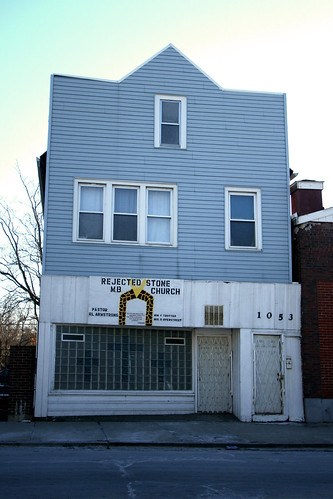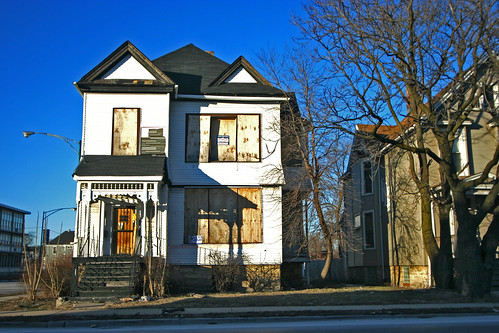
Driving through Englewood is a bit mind bending. If you stick to the main streets it looks like the rest of Chicago. Old buildings with funky stores in them, fast food restaurants, hair salons and auto repair shops are everywhere.
When I first started taking photos in the inner city, the number of store front churches also caught my eye. Denominations such as M.B., A.M.E. and Apostolic meant nothing to me. In a way it is ironic to me because at one point I attended a store front synagogue that didn't look all that much different.
In these parts of Chicago, all it seems you need to run a church is a can or two of paint, a storefront on a main street and a preacher or minister. I've wondered how many people attend services at some of these churches and how the bills get paid. I photograph as many of these churches as I can on my outings. Some are funky, some loud, some a bit sad. I probably have well over a hundred pictures. I'm looking forward to seeing how these places change over time as the neighborhoods they are located in are nothing if not transitory.
Leave the main street and things become a bit grimmer. There are the usual mix of brick, frame and greystone homes. Many are clearly remnants of a richer era. On some streets half the homes are boarded over. Young men hang out on the street tinkering with cars. One day I saw cash changing hands. I hoped it was someone paying someone back for cigarettes but I feared otherwise. The same day I slowed to take a picture of a vacant house with broken windows and saw someone looking out at me. I doubt it was the homeowner doing a little rehabbing. Yesterday in the place of a neighborhood block sign, I saw a t-shirt with the words RIP. I didn't slow to see whose name was there. It might have been a child's. On the major corners are liquor stores with older men holding brown bags hanging around outside. Sometimes you see kids and women but mostly men and teenage boys.

I don't feel safe here but I try to keep my eyes open and I keep getting drawn back. I'm not sure why. I've seen greater poverty in Mexico, Guatemala and El Salvador. But this is in my own back yard, only a few miles from my home. There is character, culture and despair here. Am I here to spy and pry or am I some sort of amateur historian or journalist? I'm not sure but if you scan the pages of Flickr you will meet a few others who take pictures in the same places I do. I hope my interest runs deeper than mere tourism. I feel that there is a story here that needs to be told.
I wonder, why are we sending Chicagoans to rebuild New Orleans when we have devastation in our own backyard? Is it because a hurricane is more romantic way to lose a home? Do we somehow blame the folks who live in Englewood for their poverty, drugs, and violence? These homes, just as historic and charming as many in the deep south, will fall to rot or be torn down because they become crack houses. And what will become of the people who live here? Perhaps as in Bronzeville, Kenwood and Woodlawn, neighborhoods that seem to be on the upswing, the poor will be pushed out by gentrification and old homes will be replaced by modern townhouses made of concrete blocks. Someone told me recently that the suburbs are becoming the new ghettos of Chicago. I'm not much of a sociologist, but will the cycle of ghettoization and white flight ever end?



7 comments:
I cannot speak to Chicago, but I can similar movements, if on a smaller scale, in my corner of the South.
There are more and mega shurches here perhaps (per square mile and per capita) but equally as important are these storefront assemblies.
Fascinating photos. Thanks for blogging.
good points. I never considered this, but it seems so clear to me now: but we don't seem to care for our own backyards. The federal government certainly isn't helping neighborhoods in New Orleans or in Chicago, not in any real way. Just in dribs and drabs so that they say they are helping.
That last house is a beautiful house. It must have wonderful stories to tell that will be lost.
I love these pictures. Sure they don't have the charm of pictures of rural France, and they're sad, but there's something that attracts me to them nonetheless.
Thanks for your comment about your Stanford in Paris experience.
I went to Stanford from fall 77 and graduated in 1981. Stanford in Tours was in fall of 1980.
I did not major in French, but in English Lit, although by the end I had enough credits for a double major -- but they weren't in the right places!
I'd love to be in touch with an alumnus; I'm not in touch with that many friends from Stanford.
Send me an email about your experience there!
you post some great pictures and even better points to ponder about the city and the people. i like that you take a genuine interest in the people, how they get along, i hope you do get a collective together about this.
I can't help but love the bluesky in the background.
~gg
They could really be cool houses with some work. Chicago is an interesting one. I lived in the South Loop for a while and there were these high rises, some built some going up, south of streets that twenty years ago everyone knew better than to go past. From my 17th floor window I had a great view of the homeless shelter half a block away with it's big lettered JESUS SAVES painted on the side. I think it might have something to do with the sudden tragedy of the hurrican opposed to the slow slide into decay. South Loop really felt like a walk in the woods, old buildings crumbling and rotting but right in next to it something young and new sprining up. Helps that there was a lot of students to live in Printer's Row and the University Village or whatever they're calling it now. But that's just me.
My father grew up in Englewood and I went back about five years ago to see the house. It had burned down. I drove through the neighborhood and saw a lot of empty lots where no one rebuilds. The old houses were elegant in their day. They are over 100 years old. I still love Englewood. The history is fascinating. The people need our help.
Post a Comment